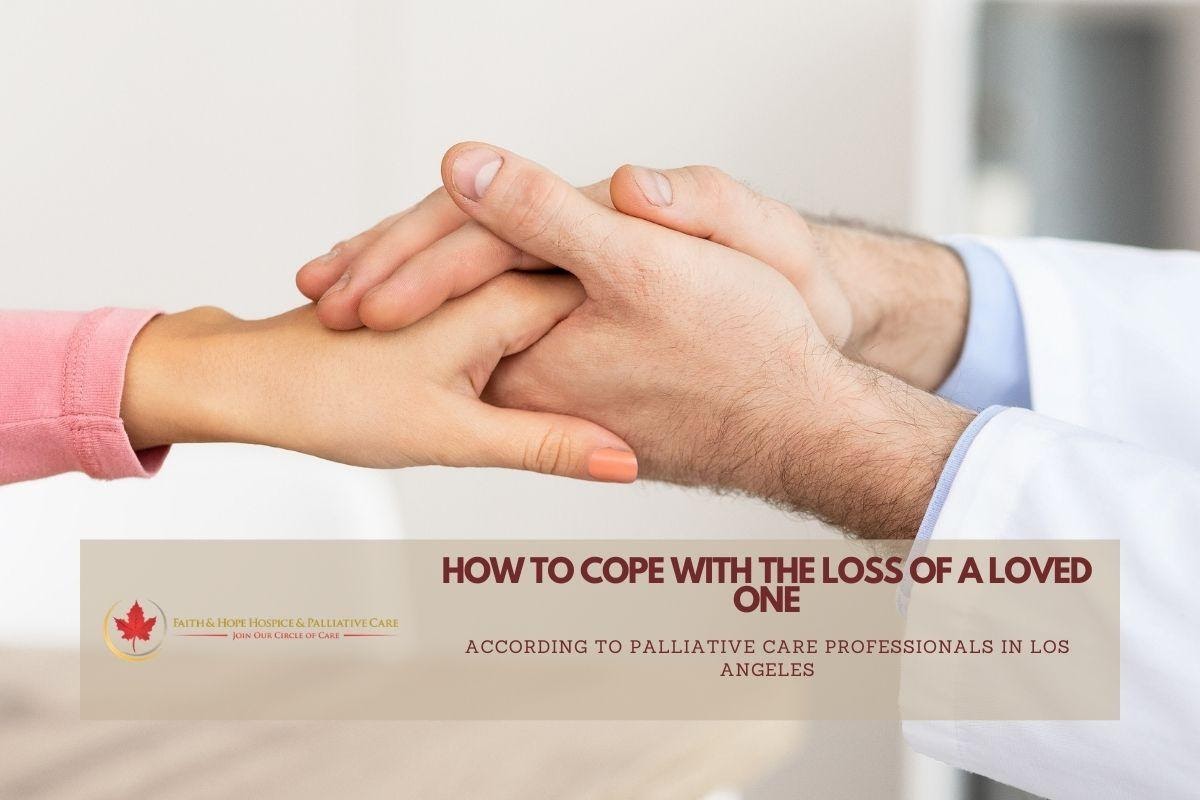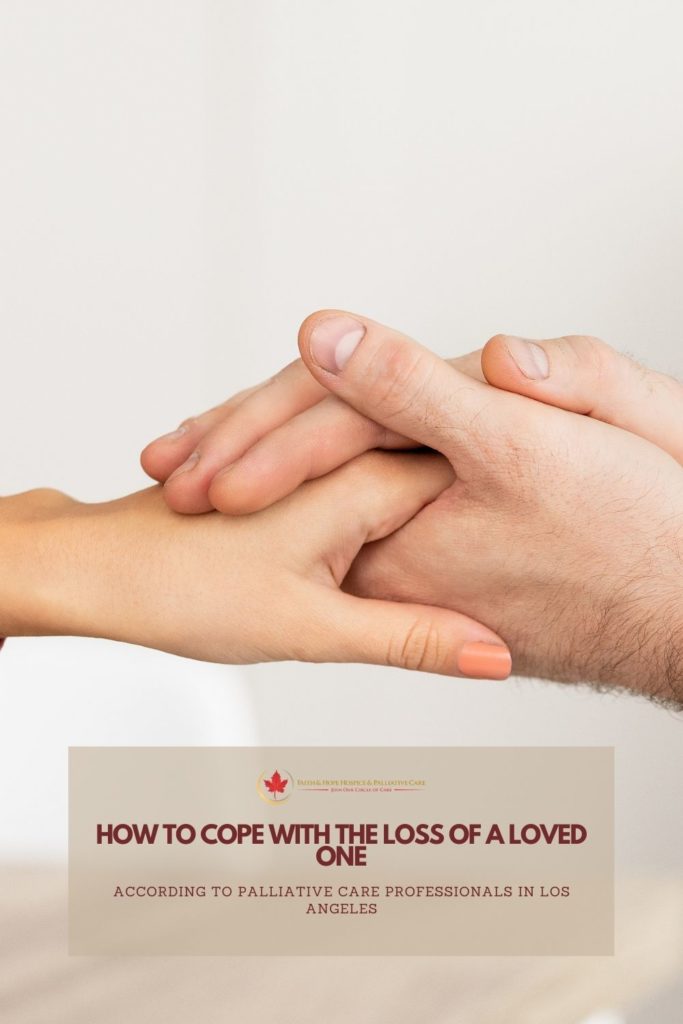
Professionals at palliative care centers in Los Angeles are truly aware that when we love someone we love, it is always going to be difficult, whether it is a positive or negative relationship or even if you know it is on the way because your loved one has a terminal illness.

Regardless of the fact that we have an idea of when someone we love at hospice Pasadena or Los Angeles is going to die, no one ever really feels completely ready to say goodbye when their death surely happens. If you do know that your loved one at hospice Los Angeles or Pasadena may die in the near future, you may have already started the grieving process before their death and this is normal, and it is known as anticipatory grief.
Carers at Los Angeles palliative care advise that you should recognize what you are feeling and share it with others who can help you on your journey. If your loved one is getting hospice care, you can receive extra support and guidance from the team, including chaplains or grief counselors they have on staff. Don’t hold back on letting them know about your struggles or the sadness you are feeling as they support and guide you on this journey since it is part of their job role.
Ultimately, there is no correct or incorrect way to grieve, but there are healthy methods to cope with the grieving process. These essential tips from palliative care professionals in Los Angeles can help you.
Grief is a natural response we have when we experience loss. It is the emotional suffering you feel when something or someone you love is taken away. For the most part, the pain of loss can feel very overwhelming. You could experience all types of difficult and unexpected emotions, from anger or shock to disbelief, guilt, and deep sadness. The pain of grief can also interfere with your physical health, making it difficult to sleep, eat, or even think logically. This is all ok because they are all normal reactions to loss, and the more significant the loss, the more intense your grief will become.
Dealing with the loss of someone or something you love is one of life’s tremendous challenges. You may link grieving with the death of a loved one – which is usually the cause of the most intense kinds of grief – however any loss can cause grief, including:
Even the slightest losses in life can bring about a sense of grief. For instance, you may grieve after moving from home, graduating from college, or changing jobs. Whatever your loss is, it is personal to you, so you don’t have to be embarrassed about how you feel, or believe that is somehow appropriate to grieve for just specific things. If the person, animal, relationship, or situation was meaningful to you, it’s normal to grieve the loss you are experiencing. Whatever is causing you a sense of grief, you can stay rest assured that there are healthy ways to deal with the pain that, in turn, can comfort your sadness and help you to come to terms with your loss, find new meaning, and eventually move on with your life.
Although grieving a loss is an unavoidable part of life, there are ways to help deal with the pain, come to terms with your grief, and over time, find a way to pick up the pieces and move on with your life.
More often than not, the pain of grief can make you want to withdraw from others and go into your shell. Nevertheless, even though you feel like this, it is good to have face-to-face support from other people to help you heal from your loss. Even if you are not comfortable talking about your feelings under normal circumstances, it is necessary to express them while you are grieving.
Try to seek comfort from people who care about you and these people and places.
Faith and Hope Hospice
We firmly believe that the internet should be available and accessible to anyone, and are committed to providing a website that is accessible to the widest possible audience, regardless of circumstance and ability.
To fulfill this, we aim to adhere as strictly as possible to the World Wide Web Consortium’s (W3C) Web Content Accessibility Guidelines 2.1 (WCAG 2.1) at the AA level. These guidelines explain how to make web content accessible to people with a wide array of disabilities. Complying with those guidelines helps us ensure that the website is accessible to all people: blind people, people with motor impairments, visual impairment, cognitive disabilities, and more.
This website utilizes various technologies that are meant to make it as accessible as possible at all times. We utilize an accessibility interface that allows persons with specific disabilities to adjust the website’s UI (user interface) and design it to their personal needs.
Additionally, the website utilizes an AI-based application that runs in the background and optimizes its accessibility level constantly. This application remediates the website’s HTML, adapts Its functionality and behavior for screen-readers used by the blind users, and for keyboard functions used by individuals with motor impairments.
If you’ve found a malfunction or have ideas for improvement, we’ll be happy to hear from you. You can reach out to the website’s operators by using the following email
Our website implements the ARIA attributes (Accessible Rich Internet Applications) technique, alongside various different behavioral changes, to ensure blind users visiting with screen-readers are able to read, comprehend, and enjoy the website’s functions. As soon as a user with a screen-reader enters your site, they immediately receive a prompt to enter the Screen-Reader Profile so they can browse and operate your site effectively. Here’s how our website covers some of the most important screen-reader requirements, alongside console screenshots of code examples:
Screen-reader optimization: we run a background process that learns the website’s components from top to bottom, to ensure ongoing compliance even when updating the website. In this process, we provide screen-readers with meaningful data using the ARIA set of attributes. For example, we provide accurate form labels; descriptions for actionable icons (social media icons, search icons, cart icons, etc.); validation guidance for form inputs; element roles such as buttons, menus, modal dialogues (popups), and others. Additionally, the background process scans all the website’s images and provides an accurate and meaningful image-object-recognition-based description as an ALT (alternate text) tag for images that are not described. It will also extract texts that are embedded within the image, using an OCR (optical character recognition) technology. To turn on screen-reader adjustments at any time, users need only to press the Alt+1 keyboard combination. Screen-reader users also get automatic announcements to turn the Screen-reader mode on as soon as they enter the website.
These adjustments are compatible with all popular screen readers, including JAWS and NVDA.
Keyboard navigation optimization: The background process also adjusts the website’s HTML, and adds various behaviors using JavaScript code to make the website operable by the keyboard. This includes the ability to navigate the website using the Tab and Shift+Tab keys, operate dropdowns with the arrow keys, close them with Esc, trigger buttons and links using the Enter key, navigate between radio and checkbox elements using the arrow keys, and fill them in with the Spacebar or Enter key.Additionally, keyboard users will find quick-navigation and content-skip menus, available at any time by clicking Alt+1, or as the first elements of the site while navigating with the keyboard. The background process also handles triggered popups by moving the keyboard focus towards them as soon as they appear, and not allow the focus drift outside it.
Users can also use shortcuts such as “M” (menus), “H” (headings), “F” (forms), “B” (buttons), and “G” (graphics) to jump to specific elements.
We aim to support the widest array of browsers and assistive technologies as possible, so our users can choose the best fitting tools for them, with as few limitations as possible. Therefore, we have worked very hard to be able to support all major systems that comprise over 95% of the user market share including Google Chrome, Mozilla Firefox, Apple Safari, Opera and Microsoft Edge, JAWS and NVDA (screen readers).
Despite our very best efforts to allow anybody to adjust the website to their needs. There may still be pages or sections that are not fully accessible, are in the process of becoming accessible, or are lacking an adequate technological solution to make them accessible. Still, we are continually improving our accessibility, adding, updating and improving its options and features, and developing and adopting new technologies. All this is meant to reach the optimal level of accessibility, following technological advancements. For any assistance, please reach out to
